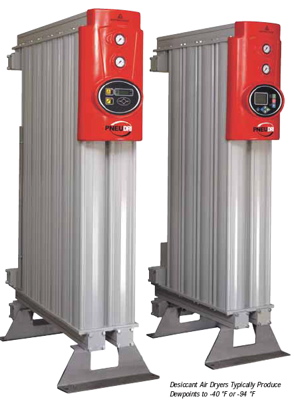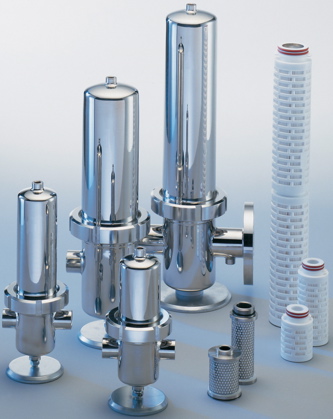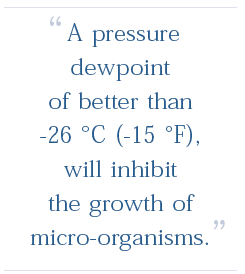Introduction
The most abundant contaminant in any compressed air system is water. This can be in either liquid or vapour form. Atmospheric air is already very wet, and becomes saturated when compressed. This water vapour will condense when the temperature drops, after the compressor, and will damage air receivers, pipework and equipment. For this reason coalescing filters and then dryers are used to remove the bulk of this water.
 Often thought of only as an oil removal filter, coalescing filters are probably the most important purification equipment in a compressed air system. Designed to remove aerosols (droplets) of oil & water, they also have the additional benefit of removing solid particulate to very low levels (as small as 0.01micron in size). Note: adsorption & refrigeration dryers are designed to remove water vapour and not water in a liquid form, they require the use of coalescing filters to work efficiently.
Often thought of only as an oil removal filter, coalescing filters are probably the most important purification equipment in a compressed air system. Designed to remove aerosols (droplets) of oil & water, they also have the additional benefit of removing solid particulate to very low levels (as small as 0.01micron in size). Note: adsorption & refrigeration dryers are designed to remove water vapour and not water in a liquid form, they require the use of coalescing filters to work efficiently.
Even with bulk liquid removed, moist, saturated air continues to cause damage and corrosion in the compressed air distribution system. Untreated compressed air is 100% saturated with water vapour and any temperature drop within the system will cause this to condense into liquid water, leading to system damage and equipment failure.
The most common mechanisms of water vapour removal are adsorption (desiccant) and refrigeration. Desiccant dryers remove the water vapour by adsorbing the water molecules onto the surface of small beads that have an exceptionally large surface area. As a result very low outlet water levels can be achieved measured as pressure dewpoint. Typical pressure dewpoints are -40°C or -70°C, (-40°F or -94°F) which means for water vapour to condense into a liquid, the air temperature would have to drop below -40°C or -70°C, (-40°F or -94°F) respectively.
Refrigeration dryers cool the air to allow the vapour to condense and the bulk liquid is then drained away. They are ideal for producing general purpose compressed air and can provide water vapour removal with pressure dewpoints of around +3°C, (+37°F). Refrigeration dryers are not suitable for installations where piping is installed in ambient temperatures below the dryer dewpoint as the remaining water vapour will condense.
Two key areas of concern, that are affected by the dewpoint of the air supplied, are the growth of micro-organisms, and the performance/life of granular filter media and catalysts. These specific subjects are addressed in the following sections.
 |
Sterile Air Filters |
Micro-organism Growth
Warm, moist air provides an ideal environment for the growth of micro-organisms. Bacteria and viruses are also brought into the compressed air system through the compressor intake. Ambient air can typically contain up to 3,850 micro-organisms per cubic metre [1]. If only a few organisms were to enter a clean environment, sterile process or distribution system, enormous damage could be caused that not only diminishes system integrity, but may cause serious physiological detriment.
A pressure dewpoint of better than -26°C, (-15°F), will inhibit the growth of micro-organisms within the compressed air system, however a refrigeration dryer cannot achieve these low water vapour levels, so a desiccant dryer must be used for breathing and medical air applications.

Activated Carbon Filter Performance
Oil vapour is simply oil in a gaseous form and will pass through a coalescing filter just as easily as the compressed air itself. Therefore, oil vapour removal filters must be employed as these provide a large bed of activated carbon adsorbent for the effective removal of oil vapours to provide ultimate protection against oil contamination. However, these granular media are “poisoned” by water vapour as adsorption sites are preferentially occupied and oil vapour removal is hindered. As a result the performance and service life of activated carbon filters is greatly reduced by the presence of high levels of water vapour.
Catalyst Performance
In medical and breathing air catalysts are often used to remove traces of any harmful gases such as carbon monoxide and NOx. These catalysts work by temporarily adsorbing the toxic gas onto their surface and allowing time for the oxygen in the air to combine with them forming harmless by-products. For example:
2CO + O2 → 2CO2
Although an asphyxiant at higher concentrations, carbon dioxide is not toxic and is preferable to carbon monoxide.
Tests performed at domnick hunter have shown that the performance of these catalysts is greatly affected by the presence of water vapour. A new catalyst element that has been vacuum packed can remove an inlet challenge of 65 ppm carbon monoxide in air down to the European Pharmacopoeia [2] limit of 5ppm for breathing air. However, a catalyst unit was left exposed to the atmosphere to allow saturation with water vapour and then tested in the same way. The “aged” cartridge could only catalyse 15ppm carbon monoxide as an inlet challenge before reaching the 5ppm limit on the outlet.
Other tests showed that using air with a dewpoint of -40°C, (-40°F) did gradually improve the performance of the catalyst, as the water vapour was slowly desorbed over time.
Conclusions and Discussion
This paper has highlighted the need for dewpoints better than -26°C, (-15°F), to avoid growth of micro-organisms, and better than -40°C, (-40°F) for increased granular filter performance and life within compressed air systems for medical air.
References
- C. T. Billiet – Specifying and achieving contamination levels in compressed air using the system of quality classes – with particular reference to humidity control, domnick hunter ltd, 1996.
- Medicinal air, European Pharmacopoeia, Fourth Edition, 2002.
For more information, please visit www.parker.com.




